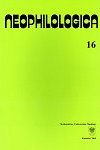L'inchoatif et les moyens de son expression en français
Inchoativity and How It Is Expressed in the French Language
Author(s): Ewa CiszewskaSubject(s): Language and Literature Studies
Published by: Wydawnictwo Uniwersytetu Śląskiego
Keywords: tense; aspect; perfective; inchoativity; type of action; past tense
Summary/Abstract: The aim of this article is a description of linguistic and grammatical ways of expressing inchoativity in contemporary French. Resigning from the traditional division into grammatical aspect and type of action (Aktionsart), the author treats the inchoative aspect as a complex structure consisting of a temporary concept and a constant one. The temporary concept holds a dominant position and is able to determine whether a given structure assumes a perfective aspect. In French the inchoative aspect may be expressed through many different forms like: inchoative verbal stems (“x s'évanouit”, “x naquit”, “x rougit”), derived reflexive forms of resultative verbal stems (“x s'inquiéta”, “x s'ouvrit”), continuous verbal stems connected with a passé simple grammatical morpheme (“x marcha”, “x chanta”), constructions composed of a verb in passé simple and an adjective (“x tomba malade”, “x devint rouge”), constructions composed of a verb and an infinitive (“x commença à pâlir”) as well as through various constructions composed of verbal forms in passé simple and nominal elements (“x se mit à l'arrosage”, “prit peur”, “x éclata en sanglots”, “le soleil se teinta de rouge”, “le silence écrasant régna d'un seul coup”).
Journal: Neophilologica
- Issue Year: 2004
- Issue No: 16
- Page Range: 7-19
- Page Count: 13
- Language: French

